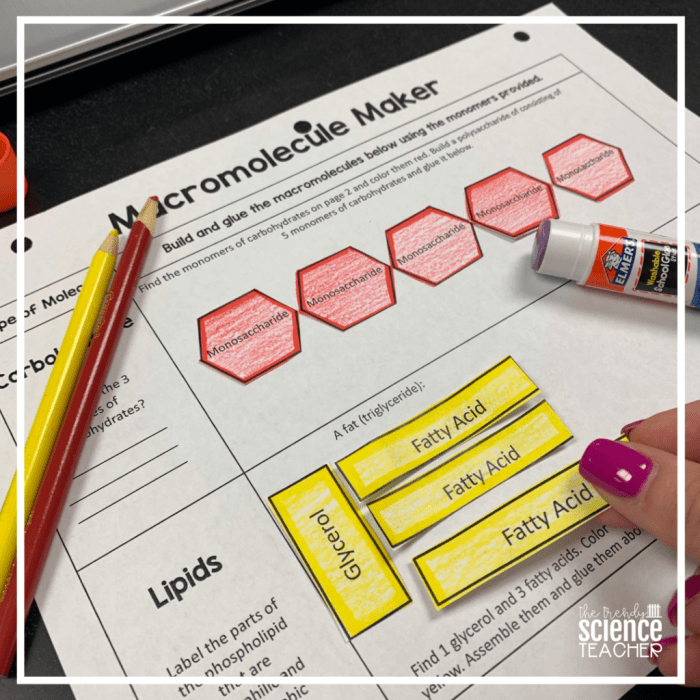The macromolecules card sort answer key provides a comprehensive guide to understanding the classification, structure, and function of these essential biological building blocks. By delving into the intricacies of proteins, carbohydrates, lipids, and nucleic acids, this key empowers learners to grasp the fundamental principles of macromolecular biology.
Through engaging card sort activities, students can actively participate in the learning process, reinforcing their understanding of macromolecular diversity and their critical roles in cellular processes.
Macromolecules

Macromolecules are large molecules that are composed of many smaller units called monomers. They are essential for life and play a variety of roles in the structure and function of cells. Macromolecules can be classified into four main types: proteins, carbohydrates, lipids, and nucleic acids.
Proteins
Proteins are composed of amino acids and are responsible for a wide range of functions in the body, including structural support, enzyme catalysis, and cell signaling. They are essential for growth, repair, and maintenance of tissues.
Carbohydrates, Macromolecules card sort answer key
Carbohydrates are composed of sugars and are the body’s primary source of energy. They are stored in the liver and muscles as glycogen and are broken down into glucose when the body needs energy.
Lipids
Lipids are composed of fatty acids and are insoluble in water. They are used for energy storage, insulation, and waterproofing.
Nucleic Acids
Nucleic acids are composed of nucleotides and are responsible for storing and transmitting genetic information. They are found in the nucleus of cells and are essential for cell division and protein synthesis.
Card Sort Activity

A card sort activity can be used to help students learn about macromolecules. The activity can be divided into three parts:1.
-
-*Preparation
The teacher should prepare a set of cards, each of which contains the name of a macromolecule or a description of its structure or function.
- 2.
- 3.
-*Sorting
The students should be divided into groups of 3-4 and given a set of cards. They should then sort the cards into four piles, one for each type of macromolecule.
-*Discussion
The students should then discuss their sorting with the teacher and each other. The teacher should use this opportunity to clarify any misconceptions and reinforce the key concepts.
Answer Key for Card Sort

The following table provides an answer key for the card sort activity.|
- *Macromolecule |
- *Description |
- *Category |
|—|—|—|| Protein | Composed of amino acids | Protein || Carbohydrate | Composed of sugars | Carbohydrate || Lipid | Composed of fatty acids | Lipid || Nucleic acid | Composed of nucleotides | Nucleic acid |
Applications of Macromolecules
Macromolecules have a wide range of applications in various fields, including:Medicine: Macromolecules are used in a variety of medical applications, such as:
-
-*Diagnostics
Macromolecules can be used to diagnose diseases by detecting the presence of specific molecules in the body.
-*Therapeutics
Macromolecules can be used to treat diseases by delivering drugs to specific cells or tissues.
-*Tissue engineering
Macromolecules can be used to create scaffolds for growing new tissues.
Biotechnology: Macromolecules are used in a variety of biotechnology applications, such as:
-
-*Genetic engineering
Macromolecules can be used to modify the genetic makeup of organisms.
-*Protein engineering
Macromolecules can be used to design and produce new proteins with specific functions.
-*Biofuels
Macromolecules can be used to produce biofuels, which are renewable sources of energy.
Food science: Macromolecules are used in a variety of food science applications, such as:
-
-*Food processing
Macromolecules can be used to improve the texture, flavor, and shelf life of food.
-*Food safety
Macromolecules can be used to detect and prevent foodborne illnesses.
-*Nutritional supplements
Macromolecules can be used to provide essential nutrients to people who are deficient in certain vitamins or minerals.
Future Directions
The field of macromolecular research is constantly evolving. Some of the potential advancements and emerging technologies in this field include:
-
-*Nanotechnology
Macromolecules can be used to create nanomaterials with unique properties that can be used in a variety of applications, such as drug delivery and tissue engineering.
-*Synthetic biology
Macromolecules can be designed and synthesized to create new materials and devices with specific functions.
-*Bioinformatics
Macromolecules can be studied using bioinformatics tools to understand their structure, function, and interactions.
These advancements have the potential to revolutionize the way we diagnose and treat diseases, produce food, and develop new materials.
FAQ Compilation: Macromolecules Card Sort Answer Key
What is the purpose of the macromolecules card sort?
The macromolecules card sort is designed to enhance understanding of macromolecular classification, structure, and function through interactive sorting activities.
How many categories are included in the card sort?
The number of categories may vary depending on the specific card sort activity, but typically includes categories such as type of macromolecule, function, and structure.
What is the benefit of using a card sort activity for learning about macromolecules?
Card sort activities provide a hands-on and engaging way to learn about macromolecules, promoting active participation and deeper understanding.
